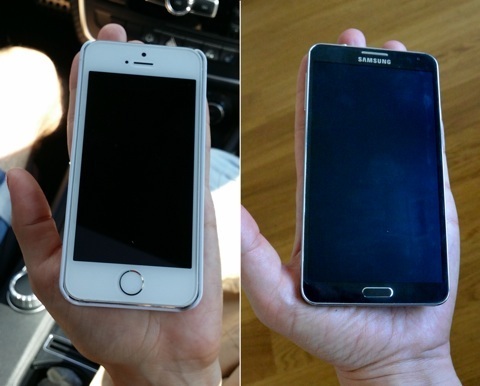Phone Sizes
When larger Android phones originally started appearing, iPhone users in particular had quite negative reactions to the trend. BGR’s Jonathan Geller wrote:
The phone is too big. You will look stupid talking on it, people will laugh at you, and you’ll be unhappy if you buy it. I really can’t get around this, unfortunately, because Samsung pushed things way too far this time.1
Linking to Geller’s article, Gruber added:
Hard to believe how much promotional effort Samsung and AT&T are putting behind this thing.
I’m not even going to link to what the Loop had to say,2 but you can do a Google search for «galaxy note» and restrict it to the site to get an impression.
(For reference, the original Note had a 5.3 inch screen. Gruber now thinks that Apple will introduce an iPhone with a 5.5 inch screen, and the regular Galaxy S5 is now at 5.1 inches.)
The interesting thing here is that there are already a lot of iPhone owners out there for whom — relative to the size of their hands — their iPhone is bigger than the Galaxy Note was for the average man who wrote these articles. It didn’t occur to these men that their hands were probably larger than the average iPhone owner’s hands, and that as a result, the iPhone they could hold easily might seem even larger to somebody else than the Note seemed to them. It shouldn’t have been a surprise that the Note turned out to sell well — after all, in relative terms, a lot of iPhone owners were already using very large phones.
On the left, a friend of mine holding her iPhone 5S. On the right, me, holding my Note 3 (that’s a 5.7 inch screen):

(The iPhone 4 was a bit smaller than the iPhone 5S shown in the picture, and the original Note was a bit smaller than the Note 3 shown in the picture, so a comparison of the 4 and the original Note would look similar.)
Phone size is relevant in two different manners: in a relative manner, and in an absolute manner.
In a relative manner, the larger a phone and the smaller the user’s hand, the harder it is to use the phone, particularly using only one hand.3 Larger people also tend to have larger pockets for phone storage.
But phone size is also relevant in an absolute manner. Larger screens can show more content, and can make the content larger. In other words, your hand size doesn’t matter when you’re watching a movie on your phone, or when you’re reading a book on your phone, or when you’re taking notes on your phone, or when you’re editing an image on your phone.4
Whether absolute size or relative size is more important to you depends on what you use your phone for.
That’s why phone size is such a difficult topic. It depends on you, and it depends on what you do with it. I’m glad that Apple is about to introduce a larger phone, but I also still believe that there are people for whom even the 5S is too big.
Addendum
Via Ashley Bischoff, an article by Zeynep Tufekci outlining some of the issues that phones designed for man-sized hands can cause:
Since officials often claimed that tear gas was used only on vandals and violent protesters, I wanted to document these particularly egregious circumstances. Almost by reflex, I pulled out my phone, a Google Nexus 4, which I had been using on this trip as my main device, sometimes under quite challenging circumstances.
And as my lungs, eyes and nose burned with the pain of the lachrymatory agent released from multiple capsules that had fallen around me, I started cursing.
I cursed the gendered nature of tech design that has written out women from the group of legitimate users of phones as portable devices to be used on-the-go.
I cursed that what was taken for granted by the male designers and male users of modern phones was simply not available to me.
I cursed that I could not effectively document how large numbers of ordinary people had come to visit a park were being massively tear-gassed because I simply could not take a one-handed picture.
I especially cursed that I could not lift the camera above my head, hold it steadily and take a picture—something I had seen countless men with larger hands do all the time.
I’m 5 foot 2 inches on a good day and my hands are simply not big enough for effective one-handed use of the kind of phones that I want to use for my work.
Increasingly, on the latest versions of the kinds of phones I want to use, I cannot type one-handed. I cannot take a picture one-handed. I can barely scroll one-handed—not very well, though. I can’t unlock my phone one-handed. I can’t even turn on my phone one-handed as my fingers cannot securely wrap around the phone while I push a button with a finger.
As an aside, I don’t understand the amount of hostility in the tech industry. It’s almost as if a tech company releasing a product you don’t want was tantamount to a personal attack on your character. These are multinational corporations who couldn’t possibly care less about us. I don’t think they deserve the kind of (negative or positive) emotional investment that we tend to have in them. 
This also depends on the OS. For example, while Android phones have a back button below the screen, iPhones have the back button in the worst possible position for people holding their phones in their right hand: in the top left corner of the screen. That’s one of the reasons why I think that a physical back button is a good idea, despite of the drawbacks. 
Samsung tried to square this circle by adding a ridiculous tiny screen mode to the Note 3. The intention was to allow you to interact with the phone in a way that made the UI more easily reachable with one hand, but still allow you to use the full screen when you wanted to. Needless to say, I don’t think it ever caught on. 
If you require a short url to link to this article, please use http://ignco.de/603

If you liked this, you'll love my book. It's called Designed for Use: Create Usable Interfaces for Applications and the Web. In it, I cover the whole design process, from user research and sketching to usability tests and A/B testing. But I don't just explain techniques, I also talk about concepts like discoverability, when and how to use animations, what we can learn from video games, and much more.
You can find out more about it (and order it directly, printed or as a DRM-free ebook) on the Pragmatic Programmers website. It's been translated to Chinese and Japanese.
Lukas Mathis's Blog
- Lukas Mathis's profile
- 2 followers



